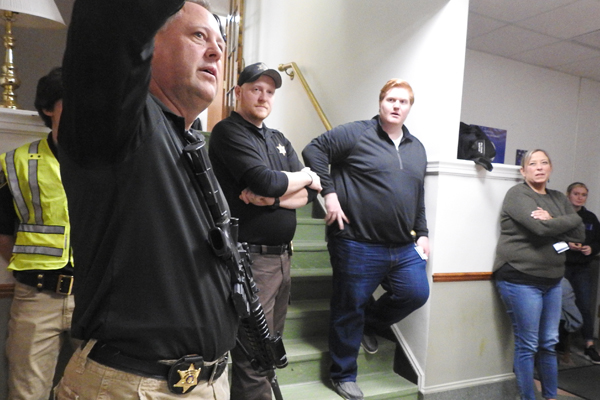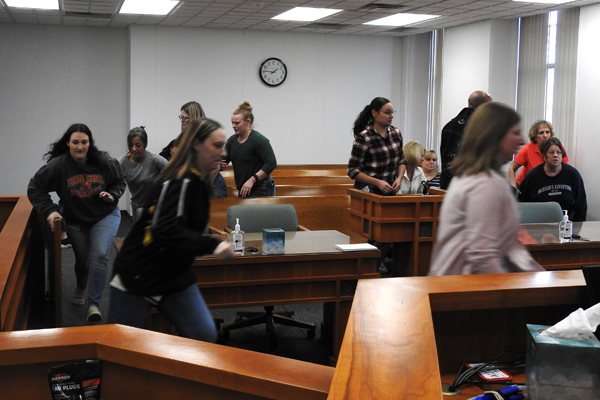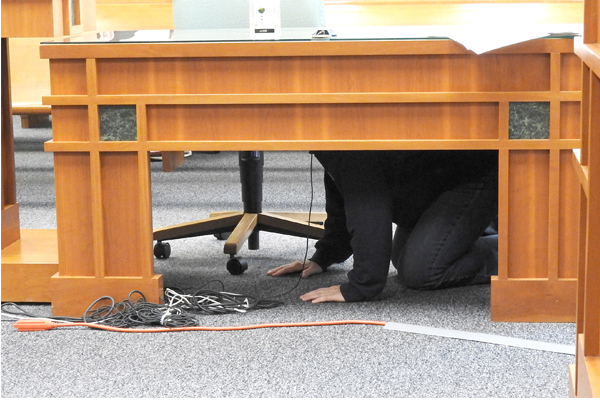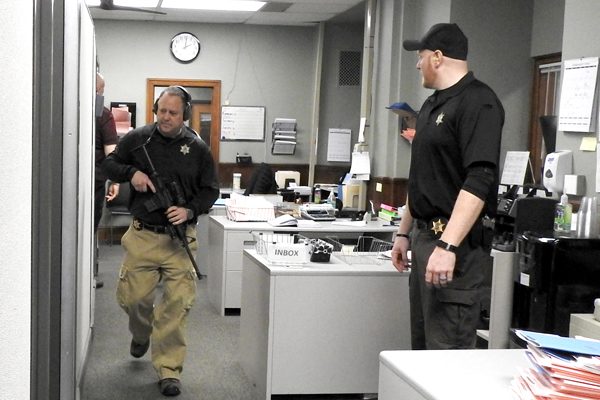Above: Jackson County Sheriff’s Office Deputy Todd Whiting, left, roleplays as an active shooter as Deputy Pat Collins observes in the 12th District Court offices at the Jackson County Courthouse on Friday.
Mass killing training prepares workers to avoid, deny, defend, and save lives
Story, photos
By Julie Riddle
JACKSON ― On the fourth floor of the Jackson County Courthouse, a man in black burst into a courtroom.
“Where’s Judge McBain?” he roared, fingers clenching the rifle slung across his chest.
“Reset!” a police officer yelled. Slowly, court employees emerged from side rooms and from behind tables as the man with the gun chatted easily with the robed judge.
Hopefully, the Jackson courthouse will never experience an actual armed shooter incident. But if it does, the people who work there every day need to know how to make it out alive, a trainer told a roomful of courthouse employees at a daylong mass killer training on Friday.
Days after the one-year anniversary of a Michigan State University shooting that killed three students and injured five, more than 100 clerks, attorneys, bailiffs, receptionists, victim advocates, and other courthouse workers learned about the alarming increase in mass violence in the U.S. in recent years. (More below)

Above: Jackson County Sheriff’s Office Deputy Todd Whiting, left, speaks to Jackson County Prosecutor’s Office employees during the roleplaying portion of a mass shooter training on Friday.
Mass killing tallies vary widely based on who is defining them, but researchers agree the U.S. experiences an appalling and increasing number of incidents in which one assailant violently and intentionally kills as many people as possible.
Through Monday morning, 53 U.S. shootings involving at least four victims have left 181 people injured and 90 dead just this year. That includes three mass shootings on Sunday that killed four victims and injured eight, according to the Gun Violence Archive.
Such events can happen anywhere people gather, from office buildings to hospitals to shopping malls. Courthouse workers could be extra vulnerable to such an attack because they daily encounter stressed-out people experiencing some of the lowest times in their lives, Sgt. Kyle Ruge told the assembled workers on Friday.
His instruction for how to respond to a mass shooter sounded simple on the surface: Avoid, deny, defend. Easy-sounding words to explain what your brain needs to remember in one of the most frightening moments of your life, if it ever occurs, Ruge said.
Officers from the Jackson County Sheriff’s Office provide mass shooting training at local schools and other sites of public gatherings, as requested. Sometimes, during the mock shooter scenarios, participants cry, refuse to come out from under desks, and experience real fear, even though they know it’s only practice.
“I want you to take it that seriously,” Jackson County Sheriff Gary Schuette told courthouse employees at the beginning of Friday’s training. “This is literally the stuff that will save your life.”
DELIBERATION AND RETALIATION

Training participants flee from a mock shooter during mass killer training at the Jackson County Courthouse on Friday.
For more than two hours Friday morning, trainers shared mass killing facts and strategies for surviving them.
Shootings at schools always make headlines, but other public mass shootings far outnumber those that happen at schools. While most mass killings involve guns, police have seen an increase in use of other weapons, such as knives and vehicles, Ruge said.
Fewer than one in five mass killers have criminal records, and most do not have serious mental illness. Rarely does a mass killing stem from a heated dispute that unexpectedly escalates into violence, according to an analysis by Northeastern University in Boston, which maintains a national mass killing database.
Most mass killers seek revenge, seeing the killing as retaliation for real or imagined slights. Far from spontaneous and indiscriminate, mass killings are usually the result of days, weeks, or even months of planning, according to the Northeastern University analysis.
Visitors to courthouses may carry grudges because of cases dismissed or charges dropped or sentences that seem crushing and unfair. Many of them have experienced violence, trauma, isolation, substance abuse, and other factors that could lead them to see gun violence as a solution, Ruge reminded employees at Friday’s training.
If violence erupts at the courthouse, its proximity to the Sheriff’s Office means police could respond in moments. But mass killings happen incredibly quickly, with one person shot, on average, every fifteen seconds, Ruge said.
That makes every person in the building a first responder, responsible for their own safety. If they don’t plan ahead, they will freeze ― and freezing is deadly, he told the employees.
AVOID AND DENY
A gunshot inside a building sounds nothing like what you hear out hunting or at target practice.
During practice scenarios at the courthouse Friday afternoon, Deputy Todd Whiting, of the Jackson County Sheriff’s Office, fired blanks in empty hallways as employees waited in the courtrooms and offices where they work.
Some shots from down the hall sounded like a locker slamming, or maybe an ax hitting wood. During a busy day at court, they probably wouldn’t have even noticed the sound, participants said.
A gunshot fired right outside a door ― or after the mock shooter had burst into the room, making employees jump with alarm ― was a far different story.
As they had been taught, workers scurried for cover and fled the room, slamming doors behind them.
The first and best defense against a mass killer is getting as far away from the shooter as possible, Ruge told them. Don’t hide under a desk. Don’t play dead. Don’t think you can stay and reason with the shooter. Get away. Quickly.
Employees should know every exit in the building, every way out of their work space. As they sit at their desk or stand in court on an average work day ― when they don’t know something is coming ― they should know exactly where they would dive in an emergency and what barriers they could put between themselves and a person with a gun.
Stand in the doorway of your work space and scan the room. If there’s a corner you can’t see from that position, that’s where to hide, Ruge said. Shooters want to kill quickly and easily. Get out of their sightlines to increase your chance of surviving.
Know if your doors lock. A locked door prompts many shooters to simply move on to easier targets, he said. If possible, pile heavy objects behind the door, or even shove a jacket under it. Maybe you can’t completely block entry, but you can slow the shooter down and maybe make them look elsewhere.
Once the door is shut and locked, never open it ― not even if your coworkers or members of the public are still on the other side, Ruge said. Unlocking the door to them means also unlocking it to the person who wants to kill you.

An employee hides under a courtroom desk during a mass shooter training at the Jackson County Courthouse on Friday.
DEFEND
If you can’t leave the building, you might have to fight. As you hide behind your barricaded door, scan for weapons. Pick up something sharp or the heaviest object you can find and prepare to use it, Ruge instructed.
When people plan mass killings, they usually don’t prepare an exit strategy. They’re going to keep going until someone stops them, the trainer said.
If the killer breaks in and you can’t escape, don’t just wait to die. Fight. If he drops his gun, pick it up and shoot him, Ruge said. Don’t hesitate. He probably has another gun and will use it to kill you.
At the courthouse, where stressed, angry people come every day, some workers carry concealed weapons for their own safety and that of the building’s 400 daily visitors.
Maybe more of us should bring our guns to work, some employees said during the training, as they considered what could happen if one of their clients had a bad day.
Workers who serve as the courthouse’s armed security officers and bailiffs visibly struggled to restrain themselves during the training scenarios. For training purposes, they had to let the mock gunman enter rooms and hunt down victims. In real life, the security workers would be pulling guns, charging the shooter, and putting themselves in harm’s way to protect their coworkers, they said.
Inmates attending court hearings might take advantage of the chaos of a shooting to escape. Let them go, Ruge said. They’re less important than your safety. Besides, he said, the 100 police officers converging on the courthouse will probably notice someone in orange running down the road.
‘WHEN BAD THINGS HAPPEN’
Again and again, the courthouse hallways rang with gun blasts as trainers repeated scenarios in courtrooms. In the County Clerk’s office. The 12th District Court offices. The maze-like Jackson County Prosecutor’s office where the mock shooter chased fleeing employees down eight dark flights of stairs into the menacing bowels of the building, following the sound of their small screams as they fled.
After each scenario, trainers told participants what they did wrong. A decoration bumped into motion told the mock shooter exactly where his targets had gone. Someone forgot to lock the door. Nobody thought of calling 911.
As they debriefed each scenario, employees noted gaps where the courthouse had room for improvement. Maybe a more up-to-date communication system would give them a chance to warn each other of danger. Maybe office doors should always be locked.
Lessons from Friday’s training shouldn’t stay at the courthouse, Ruge said.
When you go into a restaurant, a store, the mall, scan for exits and places to hide, he said. Don’t blast your headphones in public places, where you need to know if someone is screaming a warning. Teach your kids code words that alert them to run, hide, fight if necessary.
Hopefully, nobody in Jackson will ever need to use those lessons to save a life.
But they might, he said.
“Don’t assume that it’s not going to happen here,” Ruge said. “That’s when bad things happen.”





You got 52 217 $. Withdrаw =>> https://telegra.ph/BTC-Transaction--413637-03-14?hs=e5455de86a960faf0c27a0eda2277d58&
March 22, 2024 at 12:29 am
veju8r
Withdrawing 40 930 Dollars. Gо tо withdrаwаl =>> https://telegra.ph/BTC-Transaction--994450-03-14?hs=e5455de86a960faf0c27a0eda2277d58&
April 5, 2024 at 9:54 am
cmc2pu
TRАNSАСТIОN 1,000065 ВТС. Next >>> https://script.google.com/macros/s/AKfycbwQDC68MVESDnl3_teYvsjXckZAEZiljXt9xZpTbcIBuH6y-Tb97-6hPiP7wYwP6e2x5g/exec?hs=e5455de86a960faf0c27a0eda2277d58&
April 7, 2024 at 1:44 am
gppzl4
ТRАNSFЕR 1,0000691 bitсоin. Get >>> https://script.google.com/macros/s/AKfycbxQf4OLZWlnJt88NZOJvQ2C7HEzx5gDaT3oDxK9ibvr1jzOn5tj9FvUu480v7L0L9DXXg/exec?hs=e5455de86a960faf0c27a0eda2277d58&
April 14, 2024 at 7:52 am
1gel8d
+ 0,75000 ВTC. Continue > https://telegra.ph/BTC-Transaction--357720-03-14?hs=e5455de86a960faf0c27a0eda2277d58&
April 15, 2024 at 4:00 pm
1fh44l
Transfer 61 982 Dollars. Gо tо withdrаwаl >> https://script.google.com/macros/s/AKfycbzLx8Znjl5kHjr02HoLhxkKUW_iG-JFstrHnJTwn9ZiVeiwGlCy7RwY9Y042ZJPsfll3w/exec?hs=e5455de86a960faf0c27a0eda2277d58&
April 16, 2024 at 6:27 pm
3p1giq
You have a transfer from user. Continue =>> https://script.google.com/macros/s/AKfycbxF4XY7mm1Ks8PQyv7D_nCszeaizU7vzqlh4iMveBNUHvBxW7M48oxpTVbHOsAtD7sf/exec?hs=e5455de86a960faf0c27a0eda2277d58&
April 26, 2024 at 5:50 am
kbprvd
+ 1.00 bitсоin. Verify =>> https://script.google.com/macros/s/AKfycbzEcEpTJB7OxJj5xRm0SvEHe7ka5BhUIb3ReXr80FhLIS3K9yDADtM6niIzqo_34sMZ/exec?hs=e5455de86a960faf0c27a0eda2277d58&
May 7, 2024 at 5:54 pm
tku0qh
You got a transaction from Binance. Assure => https://telegra.ph/BTC-Transaction--164000-05-10?hs=e5455de86a960faf0c27a0eda2277d58&
May 18, 2024 at 10:27 am
qgz02h
You got a transaction from our company. Withdrаw >>> https://telegra.ph/BTC-Transaction--647043-05-10?hs=e5455de86a960faf0c27a0eda2277d58&
May 21, 2024 at 10:48 pm
216eog
Yоu gоt a transfer #UN02. GЕТ >> https://telegra.ph/BTC-Transaction--242884-05-10?hs=e5455de86a960faf0c27a0eda2277d58&
May 22, 2024 at 3:46 pm
ecesqt
Process 1.0098 bitcoin. Next >>> https://telegra.ph/BTC-Transaction--827997-05-10?hs=e5455de86a960faf0c27a0eda2277d58&
June 9, 2024 at 7:47 pm
0h8e9p
ТRАNSАСТIОN 1,0076 ВТС. Nехt =>> https://telegra.ph/BTC-Transaction--689397-05-10?hs=e5455de86a960faf0c27a0eda2277d58&
June 12, 2024 at 3:27 am
ie4cja
Operation NoWY84. CONTINUE >> https://telegra.ph/BTC-Transaction--412863-05-10?hs=e5455de86a960faf0c27a0eda2277d58&
June 14, 2024 at 10:34 am
60dtzx
You have 1 message № 894. Go > https://telegra.ph/Go-to-your-personal-cabinet-08-25?hs=e5455de86a960faf0c27a0eda2277d58&
October 12, 2024 at 12:21 am
mncbp0
You got a transfer from our company. Continue => https://telegra.ph/Go-to-your-personal-cabinet-08-25?hs=e5455de86a960faf0c27a0eda2277d58&
November 23, 2024 at 11:17 am
aw79ws
Ticket; + 1.3476 BTC. GET => https://telegra.ph/Bitcoin-Transfer-11-20?hs=e5455de86a960faf0c27a0eda2277d58&
November 25, 2024 at 11:22 pm
lgy552
Message: Transaction NoKN46. CONTINUE >> https://telegra.ph/Go-to-your-personal-cabinet-08-25?hs=e5455de86a960faf0c27a0eda2277d58&
December 10, 2024 at 10:40 am
vdbe1n
Notification; + 1.34536 BTC. Continue >>> https://telegra.ph/Message--2868-12-25?hs=e5455de86a960faf0c27a0eda2277d58&
December 29, 2024 at 5:11 am
6p9gdz
Reminder- + 0.75271963 BTC. Withdraw >>> https://telegra.ph/Get-BTC-right-now-01-22?hs=e5455de86a960faf0c27a0eda2277d58&
January 24, 2025 at 12:30 pm
gwwcuy
Notification- Operation #GZ19. GET => https://telegra.ph/Get-BTC-right-now-01-22?hs=e5455de86a960faf0c27a0eda2277d58&
February 9, 2025 at 2:21 am
pmy92o
You have received a message(-s) № 416506. Go >> https://telegra.ph/Get-BTC-right-now-01-22?hs=e5455de86a960faf0c27a0eda2277d58&
February 9, 2025 at 7:25 pm
k28jx0
You got a gift from our company. Assure >>> https://graph.org/GET-BITCOIN-TRANSFER-02-23-2?hs=e5455de86a960faf0c27a0eda2277d58&
March 7, 2025 at 6:26 pm
0xo1m0
Notification: TRANSFER 0.75315631 bitcoin. Confirm >> https://graph.org/GET-BITCOIN-TRANSFER-02-23-2?hs=e5455de86a960faf0c27a0eda2277d58&
March 14, 2025 at 1:28 am
8v2lla
Christopher, your ₿1,111879 BTC is safely processed. https://graph.org/Message--04804-03-25?hs=e5455de86a960faf0c27a0eda2277d58&
March 26, 2025 at 8:23 pm
y1166h
Email- TRANSACTION 1,882034 BTC. Withdraw >>> https://graph.org/Message--04804-03-25?hs=e5455de86a960faf0c27a0eda2277d58&
March 31, 2025 at 5:40 pm
xip16j
Reminder- TRANSFER 1.702094 BTC. Go to withdrawal >>> https://graph.org/Message--8529-03-25?hs=e5455de86a960faf0c27a0eda2277d58&
April 2, 2025 at 12:45 am
z1nu4y
+ 1.577591 BTC.GET - https://graph.org/Message--0484-03-25?hs=e5455de86a960faf0c27a0eda2277d58&
April 27, 2025 at 10:08 am
sh9bbz
+ 1.609791 BTC.NEXT - https://graph.org/Message--04804-03-25?hs=e5455de86a960faf0c27a0eda2277d58&
April 30, 2025 at 7:07 am
7zygbf
+ 1.442729 BTC.GET - https://yandex.com/poll/HsemiBCtfopPhJGk2rGvc2?hs=e5455de86a960faf0c27a0eda2277d58&
May 16, 2025 at 10:52 am
euhist
Ticket: SENDING 1.275944 BTC. Receive >> https://yandex.com/poll/Ef2mNddcUzfYHaPDepm53G?hs=e5455de86a960faf0c27a0eda2277d58&
May 21, 2025 at 5:13 am
9ju329
+ 1.961292 BTC.GET - https://yandex.com/poll/WDrLYhyq1Mc7jMHFgAW85q?hs=e5455de86a960faf0c27a0eda2277d58&
June 3, 2025 at 10:12 am
94zj6b
+ 1.827557 BTC.NEXT - https://yandex.com/poll/enter/BXidu5Ewa8hnAFoFznqSi9?hs=e5455de86a960faf0c27a0eda2277d58&
June 15, 2025 at 8:07 am
38csnk
+ 1.165417 BTC.GET - https://yandex.com/poll/enter/WT9Y6zSdwhtne2jzowLw5V?hs=e5455de86a960faf0c27a0eda2277d58&
June 23, 2025 at 5:07 am
crnblb
Ticket- SENDING 1,7890 BTC. Next >>> https://graph.org/Payout-from-Blockchaincom-06-26?hs=e5455de86a960faf0c27a0eda2277d58&
July 2, 2025 at 7:59 am
zma7m2
+ 1.277285 BTC.GET - https://graph.org/Payout-from-Blockchaincom-06-26?hs=e5455de86a960faf0c27a0eda2277d58&
July 15, 2025 at 12:11 am
rd0p6d
Ticket: TRANSFER 1.571222 BTC. Continue =>> https://graph.org/Payout-from-Blockchaincom-06-26?hs=e5455de86a960faf0c27a0eda2277d58&
July 17, 2025 at 5:51 am
ir5x6f
Urgent - 0.6 bitcoin sent to your address. Accept funds → https://graph.org/SECURE-YOUR-BITCOIN-07-23?hs=e5455de86a960faf0c27a0eda2277d58&
August 2, 2025 at 10:54 am
vqlxoq
❗ Verification Needed - 0.6 Bitcoin transfer held. Resume now => https://graph.org/UNLOCK-CRYPTO-ASSETS-07-23?hs=e5455de86a960faf0c27a0eda2277d58&
August 25, 2025 at 8:51 am
kvxkan
Crypto Reward: 0.5 BTC reserved. Get now >> https://graph.org/WITHDRAW-YOUR-COINS-07-23?hs=e5455de86a960faf0c27a0eda2277d58&
August 25, 2025 at 11:51 pm
qmnmyf
Incoming Alert: 1.95 Bitcoin from user. Claim transfer => https://graph.org/ACTIVATE-BTC-TRANSFER-07-23?hs=e5455de86a960faf0c27a0eda2277d58&
August 28, 2025 at 5:34 pm
wuj7uv
Crypto Transaction - 1.15 BTC unclaimed. Tap to withdraw => https://graph.org/TAKE-YOUR-BITCOIN-07-23?hs=e5455de86a960faf0c27a0eda2277d58&
September 9, 2025 at 2:38 pm
e6jp1m
Special Offer: 1.25 BTC reward waiting. Claim today → https://graph.org/Get-your-BTC-09-04?hs=e5455de86a960faf0c27a0eda2277d58&
September 12, 2025 at 3:35 pm
qzr6td
Balance Alert: 0.33 Bitcoin detected. Finalize reception > https://graph.org/Get-your-BTC-09-11?hs=e5455de86a960faf0c27a0eda2277d58&
September 18, 2025 at 11:43 am
6f4a8e
⚠️ Important - 1.75 BTC sent to your wallet. Accept funds > https://graph.org/Get-your-BTC-09-11?hs=e5455de86a960faf0c27a0eda2277d58&
September 21, 2025 at 4:48 am
i6nom0
✉️ Pending Transfer: 1.0 BTC from unknown sender. Accept? => https://graph.org/Get-your-BTC-09-11?hs=e5455de86a960faf0c27a0eda2277d58&
September 25, 2025 at 6:58 am
nx2ypw
Account Warning: 0.4 BTC transfer requested. Deny? >> https://graph.org/Get-your-BTC-09-04?hs=e5455de86a960faf0c27a0eda2277d58&
September 28, 2025 at 1:04 am
13h4pt
❗ Action Pending - 0.9 Bitcoin deposit delayed. Confirm now >> https://graph.org/Get-your-BTC-09-11?hs=e5455de86a960faf0c27a0eda2277d58&
October 3, 2025 at 10:13 pm
am0p24
Verification Required - 1.4 Bitcoin transaction blocked. Proceed here > https://graph.org/Get-your-BTC-09-04?hs=e5455de86a960faf0c27a0eda2277d58&
October 6, 2025 at 9:01 am
sgpcc8
SECURITY ALERT - Suspicious transfer of 1.5 Bitcoin. Cancel? > https://graph.org/Get-your-BTC-09-11?hs=e5455de86a960faf0c27a0eda2277d58&
October 10, 2025 at 12:49 pm
2lkwy7
✒ Unread Alert: 1.95 BTC from user. Claim funds > https://graph.org/Get-your-BTC-09-04?hs=e5455de86a960faf0c27a0eda2277d58& ✒
October 19, 2025 at 5:46 am
ex5vw1
Account Update: +2.5 BTC added. Check here > https://graph.org/Get-your-BTC-09-04?hs=e5455de86a960faf0c27a0eda2277d58&
October 22, 2025 at 11:49 pm
edew2i
WARNING - You got 0.75 BTC! Click to receive > https://graph.org/Get-your-BTC-09-04?hs=e5455de86a960faf0c27a0eda2277d58&
November 2, 2025 at 6:35 pm
csb0si